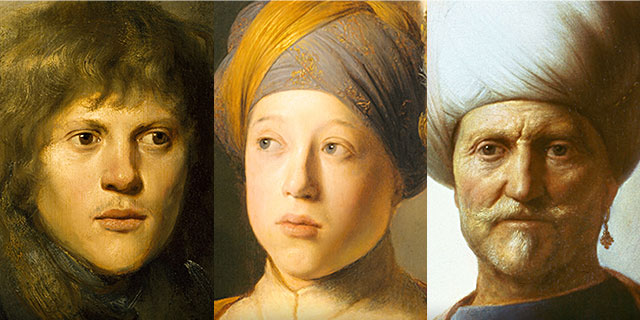Chronology
Friends and Rivals: Jan Lievens and Rembrandt
1634–35 Van Dyck leaves the English court for commissions in the Southern Netherlands, but returns to London after one year and resumes position as court painter
1635–44 Lievens leaves London for Antwerp, perhaps feeling displaced by Van Dyck’s return. In the Southern Netherlands, Lievens is influenced by both the subjects and styles of Peter Paul Rubens and Adriaen Brouwer
1635 Rembrandt produces a group of four tronies based on prints Lievens published in Antwerp, suggesting that Lievens and Rembrandt are in contact after Lievens arrives in Antwerp
1639 Lievens receives commission for The Magnamity of Scipio for the council chamber of the town hall in Leiden; Lievens painted this Rubens-inspired work in Antwerp
1639–40 Lievens visits Leiden and resumes contact with Huygens, whom Lievens portrays in a black chalk drawing. Upon completion, Lievens paints The Sacrifice of Isaac based on Rembrandt’s version of the same subject. Lievens acquires Antwerp citizenship and marries in a Catholic service, suggesting a conversion to Catholicism during his stay in Antwerp
1642 Rembrandt paints The Nightwatch
1644 Perhaps due to financial difficulties, Lievens moves to Amsterdam and produces fashionable portraits that show the influence of Van Dyck
1647 Lievens is invited to participate in the decoration of Huis ten Bosch, a small summer palace of Prince Frederik Hendrik near The Hague. Lievens contributes a large allegory of The Five Muses as part of a memorial for the prince
(return)Late 1640s/early 1650s Rembrandt’s dark, highly personal style continues to fall from favor, while Lievens increasingly attracts illustrious Amsterdam sitters such as Adriaen Trip, Anna Maria van Schurman, and René Descartes
1653–54 Lievens moves to Berlin to participate in the decoration of the Schloss Oranienburg in Bützow for Frederich Wilhelm von Hohenzollern, Elector of Brandenburg
1655 In The Hague, Lievens continues to receive important commissions, including one for a lunette painting depicting Brinio Raised on a Shield for a chamber in Amsterdam’s town hall. Other artists who received commissions for the same room include Govaert Flinck, Jacob Jordaens, Ferdinand Bol, and Rembrandt; Rembrandt’s work apparently did not satisfy the burgomasters, because it was installed but removed shortly afterwards
1657/58 Rembrandt faces bankruptcy and sells off much of his property and private art collection to pay debts
1659 Lievens returns to Amsterdam for the last time and is recorded there as a citizen in 1660
1664 Lievens travels to Cleves; little is known of this trip or of his work after the mid–1660s
1666 Lievens is once again living in Amsterdam; he begins to suffer from financial difficulties
1669 Rembrandt dies a pauper in Amsterdam
Early 1670s Lievens returns briefly to The Hague and to Leiden
1674 Lievens dies in poverty in Amsterdam






